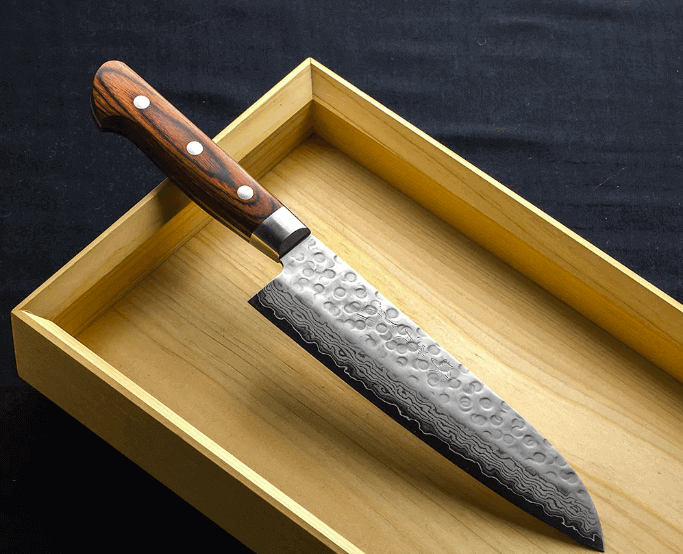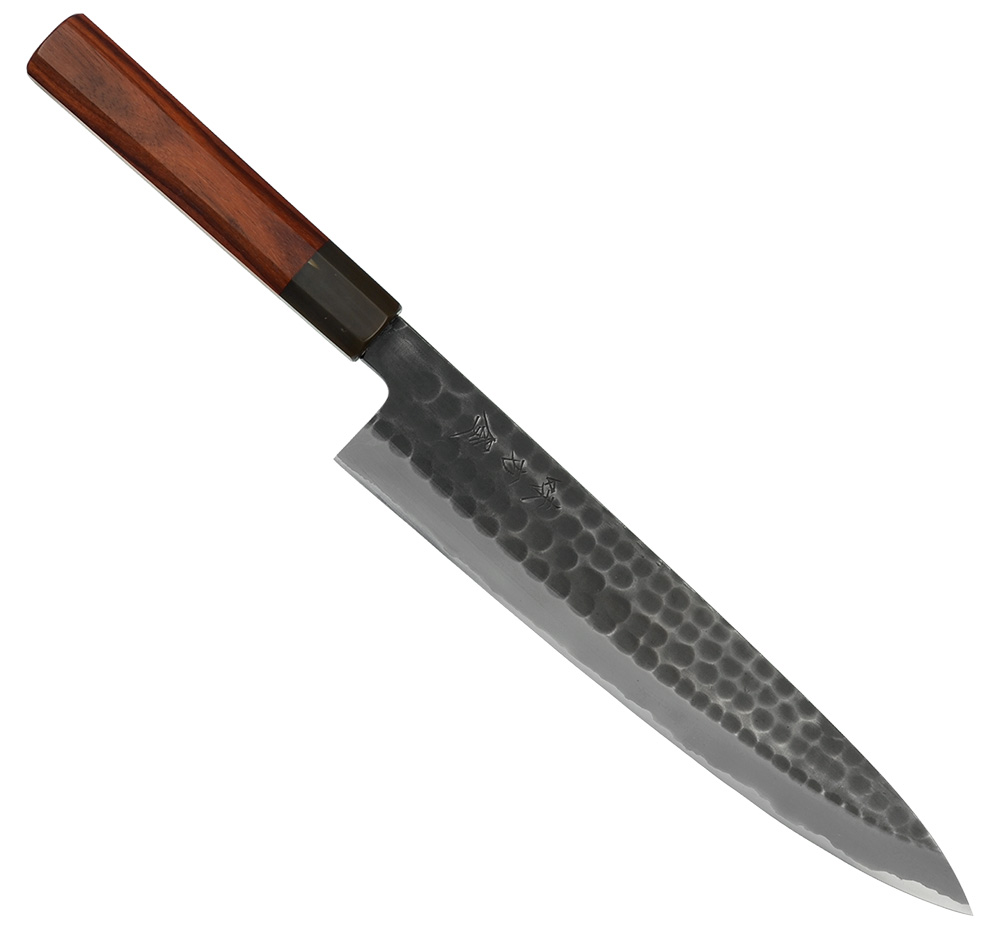Japanese chefs have a collection of knives and each is ideal for different purposes and tasks. Two of the most commonly used knives are the Santoku knife and the Gyuto knife.
These are not just popular with Japanese chefs, but also with professional chefs from around the world who prefer Japanese knives to Western knives. Enthusiastic home cooks also like to buy Japanese knives to create beautiful dishes in their own home. If you are considering buying either a Santoku or a Gyuto, this post may help you decide which is the best option for you.
So without further ado, let’s start the Gyuto vs Santoku showdown.
What is a Santoku Knife?

Officially, this knife is called a Santokubocho and it is also known as a Bunks bocho. Originating from Japan, the Santoku knife is a general purpose chef’s knife that is used in a variety of ways.
Its name translates to ‘three uses’, referring to its uses for mincing, dicing, and slicing. As it is used in so many ways, it is a versatile addition to a knife set.
Characteristics of a Santoku Knife
Each of these two Japanese knives has different features. Typical characteristics of a Santoku knife include:
- Blade shape: The shape of a Santoku knife is described as a sheepsfoot. This is because the blade edge is almost flat, but the blade spine is curved to the point.
- Blade length: Usually, a Santoku blade will measure between 5-7 inches.
- Knife motion: There is very little motion in a Santoku blade because of the flat blade edge.
- One-side edge: A Santoku knife edge is sharpened on only one side to an angle of between 12-15 degrees.
- No bolster: There is no bolster on most Japanese knives, so they are easier to sharpen.
- Hardness: A Santoku is harder than Western knives but is generally softer than a Gyuto.
What is a Gyuto Knife?

A Gyuto knife is also known as a beef-sword and it is the Japanese equivalent to the Western chef’s knife. It typically has a curved blade with an extended tip for quick chopping.
It is also highly versatile, as you can use the heel of the knife for chopping large pieces of meat or you can use the tip for making fine cuts. You can also use this knife for preparing vegetables.
Characteristics of a Gyuto Knife
The design of a Gyuto differs from that of a Santoku as they have different purposes. Some of the characteristics of a Gyuto include:
- Blade shape: The blade of a Gyuto knife has a curved spine and edge with a pointed tip.
- Blade length: The blade of a Gyuto is usually between 8-11 inches.
- Knife motion: It allows for a rocking motion, similar to that of the Western chef’s knife.
- Hardness: The blade of these knives is hard so that you can cut through tougher ingredients.
Pros and Cons of a Santoku Knife
With regard to the Gyuto vs Santoku, there are definite pros and cons to consider. Let’s start with the Santoku.
There are many reasons why the Santoku is one of the most popular knives used by Japanese chefs. Some of the pros of a Santoku knife include:
- Precision cutting: It has a think blade that is ideal for precision cutting, such as finely chopping vegetables.
- Thin blade: The thin blade of this knife is ideal for thinly slicing meats and fish.
- Lightweight: A Santoku is a lightweight knife and this means it is easy to use.
- Control: This knife is easy for a chef to control and this is predominantly because the knife’s edge is only sharpened on one side.
- Edge retention: These knives retain their edge well and this means there is less need for sharpening.
- Easy to sharpen: Not only can this knife retain an edge well, but it is also easy to sharpen.
There are also some downsides to this knife. These include:
- Flexible blade: These knives tend to be flexible, and may be challenging to use for cutting tougher ingredients.
- Lack of bolster: As there is no bolster on most of these knives, there is no protection to stop your fingers sliding onto the blade.
A bolster is the balancing point between the handle and blade. It serves a dual purpose of both protecting fingers from the blade and increasing comfort for the user.
Pros and Cons of a Gyuto Knife
When used for the right purposes, a Gyuto is an excellent addition to a knife set. Here are some of the benefits:
- Curved blade: The curved blade means this knife has a rocking motion similar to the Western chef’s knife and is ideal for chopping hard vegetables, such as carrots.
- Versatility: You can use these knives on most types of ingredients.
- Robust: This is a robust knife that is suitable for chopping and slicing tougher ingredients and even jointing meat.
- Thin blade: The thin blades of these knives means you can use them for precision tasks, such as finely slicing meat, fish, or vegetables.
There are also some disadvantages to these knives. These include:
- High maintenance: It is recommended that you use a water stone to sharpen these knives after every use, so they are quite high maintenance.
- Lack of bolster: As with the Santoku, there is typically no bolster on Gyuto knives to both protect your fingers and provide comfort.
While it is true that the Gyuto vs Santoku comparison is slight, other Japanese knives are quite different in both shape and functionality. These include the cleaver and others.
Read more >> 5 Best Japanese Cleavers from Shun, Zhen, Dalstrong & More
Read more >> 15 Best Japanese Knives for All Budgets in 2025

The Bottom Line
When it comes to considering the Gyuto vs Santoku, which knife should you purchase? The primary consideration you should make when choosing is the purpose for which you intend to use the knife.
If you need a knife for meat preparation, then a Gyuto is likely the best option. On the other hand, if you plan to predominantly prepare vegetables or use the knife for precision work, then a Santoku is likely a better choice.
For those who want to build a collection of knives for various tasks, it makes sense to consider buying both types of knives to add to your collection. If you can only afford to buy one knife, then we recommend the Gyuto as this is the most versatile option.
However, keep in mind that most Japanese knives can be expensive, and this should factor in your decision.
Read more >> Why are Japanese Knives so Expensive?